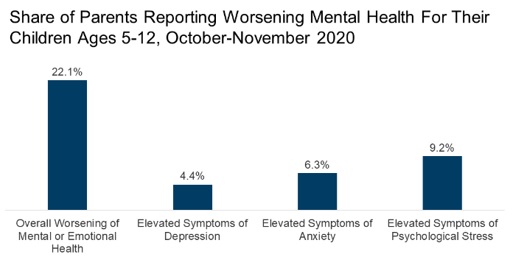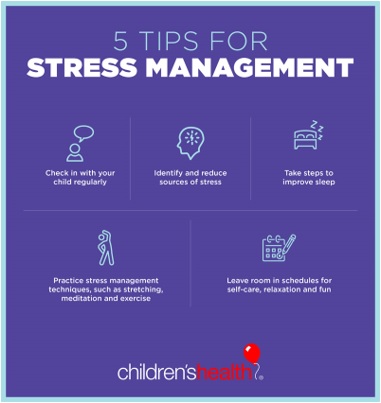5 Essential Stress Management Tips To Teach Young Children
27th September 2023
Stress is part and parcel even for a student’s life. While it may manifest differently in young minds, it's crucial to equip them with the tools to understand and manage stress from an early age. Teaching young children about stress not only helps them navigate challenging situations but also lays the foundation for emotional intelligence and resilience. Read on to learn about stress and how to openly talk about negative emotions with your child.
Types Of Anxiety And Stress In A Child

Source: kff.org
Here are some of the most common types of stress found in young children:
- Separation Anxiety
This is typically experienced by children of up to 3 years. When they start to sleep alone or attend preschool they dislike the feeling of being separated from their parents.
- Social Anxiety
This is faced by students when they join a new school, a new club, a new study group, etc. They fear not being able to blend in and make friends.
- Emotional And Situational Stress
This is common in children with severely reduced adult support systems. Children experiencing abuse, neglect, violence, substance abuse, economic hardships, etc. face this type of stress.
- Academic Stress
This is common in children who struggle with their academics or are being bullied.
- Life Event Stress
This stress is triggered by family illness, parents' divorce, loss or death of loved ones, or even change of place.
Hey, do you follow us on Social Media? We regularly share upgraded educational content, tips, feedback and more. Check us out by clicking the profiles here - Facebook / Twitter / LinkedIn / Pinterest / Instagram / YouTube
Symptoms Of Stress In Children
Some of the most common symptoms that children with stress display are:
- Bad mood or increased irritation
- Anger outbursts
- Sleeping trouble
- Reduced confidence
- Bedwetting
- Avoidance
- Lack of focus
- Excessive fidgeting
- Nail biting
- Nightmares
5 Steps To Teach Children About Stress

Source: childrens.com
If you want your child to talk about stress and anxiety openly, here are some steps to follow:
1. Create a Safe and Open Environment
The first step in teaching young children about stress is to establish a safe and open environment where they feel comfortable discussing their emotions. Encourage them to express their feelings, whether positive or negative, without fear of judgment.
Active listening is key; show genuine interest in what they have to say and validate their emotions. This helps children develop trust and confidence in discussing stress-related issues.
2. Use Age-Appropriate Language and Concepts
When discussing stress with young children, it's essential to use age-appropriate language and concepts. Avoid complex terminology and focus on simple, relatable terms. Use stories, drawings, or age-appropriate books to illustrate stress and its impact.
For instance, you can use a story about a character who feels worried before a big test or anxious before a playdate to help children understand stress in a relatable context. Tailoring your approach to their developmental stage ensures better comprehension and engagement.
3. Teach Stress Awareness and Coping Strategies
Young children often experience stress but may not recognize it. Teach them to identify physical and emotional signs of stress, such as a racing heart, sweaty palms, or feeling upset. Encourage them to label these sensations when they occur. Once they are aware of stress, introduce age-appropriate coping strategies.
Breathing exercises, like taking deep breaths or blowing up an imaginary balloon, can help children calm their bodies. Additionally, simple mindfulness exercises, such as focusing on their breath or a favorite toy, can teach them to stay present and manage stress.
4. Foster Resilience Through Problem-Solving
Resilience is a vital skill for managing stress effectively. Teach children problem-solving skills by involving them in age-appropriate decision-making processes. When they face a stressful situation, guide them through the steps of identifying the problem, brainstorming possible solutions, and selecting the best one.
Encourage them to reflect on the outcomes and adapt their approach in the future. This process not only empowers children but also helps them build confidence in their ability to overcome challenges.
5. Lead by Example
Children learn best by observing their caregivers. As a parent, teacher, or guardian, it's essential to model healthy stress management techniques. Show children how you cope with stress in your own life.
Explain your emotions and the strategies you use to manage them. Demonstrating resilience and effective stress management sets a powerful example for young minds to follow. Encourage open conversations about your own experiences with stress, emphasizing that it is a normal part of life and that everyone encounters it.
Make Your Students Emotionally Resilient
Teaching young children about stress is a crucial aspect of their emotional development. You can start by pursuing an international teaching diploma in Bangalore or any location near your residence. This will allow you to identify the symptoms and take action accordingly. Listen to your students, pay attention to your body language, or check in on them through discussion to know how they are doing. With this, you will understand their mindset and lay the foundation for emotional well-being and resilience.
We believe education should be accessible for everyone. That’s why we don’t charge for our blogs. Find the right course that will help you in your career with us, contact us at - 1800-212-6400. You can mail us at act@asiancollegeofteachers.com.
Written By : Sanjana

